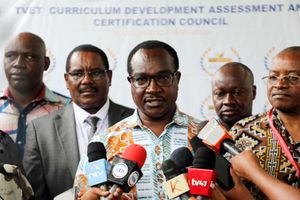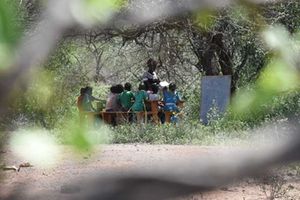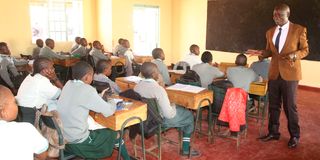
Kakamega Primary School and Junior Secondary School Grade 9 learners during a lesson on January 6, 2025. Learners are expected to pick their senior schools before undertaking the Kenya Junior School Education Assessment in November.
The process to admit more than 1.2 million learners to senior school in January next year will begin in two weeks with the selection, by each learner, of 12 schools for their chosen career pathways.
The Ministry of Education is expected to provide the new categorisation of schools according to pathways available in each of them, a deviation from their identification as national, extra-county, county or sub-county schools.
Senior school selection will run from May 26 to June 15, while placement will be done after the results of the Kenya Junior School Education Assessment (KJSEA), which will be administered for the first time in November.

Head of the Directorate of Secondary at the Ministry of Education William Sugut.
According to the head of the Directorate of Secondary at the Ministry of Education, William Sugut, a learner’s interest, teacher’s input and academic performance will be critical aspects in the placement system. The parents will also be involved to guide the learners.
Social Sciences
The pathway choices available to learners in senior schools are: Social Sciences, Arts and Sports, and Science, Technology, Engineering, and Mathematics (STEM). The pathways then branch off into tracks (the specific learning areas - subjects).
“The placement results will show where learners have been placed, then their admission letters joining as has been the practice will be accessed online using the learner's assessment number,” said Dr Sugut.
The current national schools will offer all three pathways due to their capacity and superior infrastructure, while other schools will offer STEM and either of the other two.
“We are now done with the registration for assessment, but what is remaining is the selection of pathways and tracks, including the schools for purposes of ensuring that we tap into the talent of learners,” said Dr Sugut.
Pathway of interest
“In terms of step-by-step [process], the teacher who is guiding the selection will log in to the school’s National Education Management Information System (Nemis) account, then the names and the assessment number of Grade 9 learners in that institution will pop up,” explained Dr Sugut.
The teacher will then take learners through the selection process, update and save their details, including their home county and sub-county. For transparency, the teacher will need to confirm those present during the selection process (like parents).
“Because we expect the parent, the learner and the head of the institution to be there during the process to guide the child. The learner will then be guided to select the pathway of interest, and then subsequently, select the track of interest in that same pathway,” said Dr Sugut.
The learner will thereafter proceed to select the first subject combination before being guided to select four senior schools. These include: a day school, a boarding school from their home county and two others (boarding) from outside their home county.
Dr Sugut said the same process will be repeated for the second and third subject combinations of the learner to give room for flexibility.
He said the Ministry of Education and the Kenya National Examinations Council (Knec) will work on the rest of the logistics for placement purposes.
During the national conversation on Competency-Based Education, Dr Sugut explained the process, adding that the MoE has separated the registration for the KJSEA from the selection of pathways and tracks.
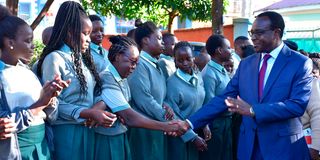
Cabinet Secretary for Education Julius Migos Ogamba shakes hands with JSS pupils during the official opening of JSS classrooms at Kakamega Primary School in Kakamega County on December 4, 2024.
He said various Ministry of Education officials, led by the Cabinet Secretary Julius Ogamba, will have important roles in the process. Others are the Principal Secretary for Basic Education, the Director General of Education, the Head Directorate of Secondary Education, and field officers, regional and county directors of education, principals of senior schools and heads of junior schools.
“What is critical among all these is that we should be able to identify and nurture the talent of every child. Therefore, when they make choices, if a child is very good at both STEM, Social Sciences and Arts and Sports, that is why we bring in the interest; what is your choice?” Dr Sugut posed, urging teachers to place learners correctly.
In junior school, the learners pursue nine learning areas, while in senior school, they will undertake seven subjects, four of which will be compulsory, including mathematics.
Select 12 schools
“Given that the first cohort of CBE learners is in Grade 9, we therefore need to firm up their transition to senior school. The learners will select 12 schools for their chosen pathways as follows; four schools in their first choice, four for the second and four for the third choice,” he explained.
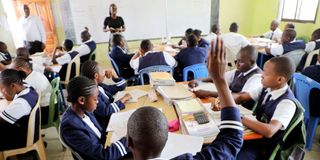
Grade 9 learners at Fairfield Primary School in Mombasa during a lesson.
In terms of accommodation, out of the 12 schools, nine should be boarding schools. Three of them will be from the learner’s home county, while six will be from outside the county.
Dr Sugut said learners will also select three day schools from their sub-county of residence.
“We are aware of schools that will do pre-selection like Starehe Boys Centre and the others,” he said
The learners’ academic performance in KJSEA will be cumulative, having undertaken assessments in Grade 6, Grade 7 and Grade 8, and the summative assessment at the end of Grade 9.
To ensure equity, the MoE will place the top six learners per gender in each STEM track per sub-county in boarding schools of their choice. It will then place the top three learners per gender in each social science track same as in arts and sports.
Schools with vacancies will declare, and those that wish to make any changes are expected to do so two weeks before the reporting date.

